As fractional agency managers, we’re often tasked with leading annual planning and strategy...
Why Agency-Client Relationships Fail (and How To Fix It with NotebookLM)

If you’d like to watch a video instead of reading a blog post, you can find a full walk through here.
Agency-client relationships don’t usually collapse because of a missed email or a late deliverable. They rarely fall apart when a key team member leaves, either. They fail because of lost context, the invisible thread that connects what was sold, what was promised, and what the client actually expects, even as that expectation grows and changes with time.
The Problem of Context
Every healthy agency builds institutional knowledge from hundreds of small interactions. Sales calls, project updates, random Slack threads. Over time, these moments form a story: what the client values, fears, celebrates, and actually needs. The best agencies are able to capture and structure this story so it belongs to the agency, not any one individual.
This is what builds trust between the client and the agency as a whole, not just between the client and one or two senior people on the agency team.
But new resources or account managers coming onto a project aren’t going to want to sift through hundreds of Slack messages to understand the story, and a simple AI summary of the client’s documents may not be in-depth enough to provide the information the new resource needs to immediately show to the client that their context is understood by the agency.
That’s where NotebookLM can be incredibly helpful. It’s typically available in GSuite, which a lot of agencies use, and using it to provide queryable context for anyone who wants or needs to know the full picture of what’s going on in a client account can be incredibly useful.
NotebookLM as Your Client Context Hub
NotebookLM was originally built for studying and research. You can upload multiple sources (documents, transcripts, PDFs, audio files), and then query them in natural language. If you are keeping and structuring documents about your clients in the right way, we discovered it can be an incredibly powerful way to quickly onboard new delivery or account resources.
Step 1: Structure Your Sources
Store sales notes, account plans, meeting transcripts, kickoff decks, SOWs and proposals in tab-structured documents or PDFs. It’s also helpful to put dates in front of each entry. We like to have the following at least:
- A sales notes document that provides an overview of the opportunity, proposal versions and call transcripts. This remains as an artifact once the opportunity is closed/won. This may become less relevant over time, but the original context the client brought into the relationship with the agency is often a key piece of information that can help smoothing out any issues later.
- A sales-to-services handoff document that summarizes the state of the work at the moment of kickoff. We talk about that more here and have a template available for download here.
- PDFs of proposals, SOWs and kickoff decks.
- A client account notes document that details the account plan or roadmap, call transcripts, the weekly updates (or however you are providing overview updates for your client stakeholders), running internal notes, and any issues that have been on the account.
Even if some of this lives in your PM tool or CRM, it’s still worth it to move some of the information into a structured document. This lays the groundwork for faster, more consistent onboarding later.
Example of a structured document:

Step 2: Decide on your Collaborators
These documents should be a candid look at the true state of the account. That means team members may be mentioned by name, both in positive and negative ways. Decide early on who should have access to the Notebook. Just the account manager and account team leads and the executives? The whole team? This is more dependent on your culture and how your teams work together and there is no hard and fast rule; the more people who CAN access it, the better.
Note that NotebookLM cannot be added to a drive folder (yet, though that would be nice). Instead you do have to share it out specifically with individual and/or groups.
Step 3: Add Your Sources and Keep them Updated
Once you’ve added a doc as a source, NotebookLM makes a static copy. If the source document changes, you will need to hit “Click to sync with Google Drive.” NotebookLM gives this visual cue if it detects the document was last updated after it made its static copy, so it should be easy to tell when the document has been updated.

Keeping the documents themselves updated is really just about moving context into the docs a team habit. If there is a major update about the account via Slack, for example, copy-pasting that into the structured document can pay off later. The more context the better, so any communication or information that can be logged in these documents will contribute to how queryable the information is later.
Step 4: Query and Pin
If you have a particularly helpful conversation, you can pin this conversation as notes and all collaborators can see the results of that chat over in the studio section (lower righthand corner). You can ask the things you’d ask the account manager, like:
- What are the top 5 things I need to know if I am a new account manager coming onto this account?
- What are the biggest churn risks in this account?
- Can you give me a very brief summary of the history of this account with our agency?
NotebookLM is designed to query large amounts of text and return summaries with cited sources, so you can quickly see why the tool is summarizing certain documents in the way it is. This is helpful because your human eyes may see something different from what the LLM sees, and unlike other LLMs, Notebook will cite exactly where it got its information from in your source documents.
The Takeaway
Agencies succeed when they have institutional memories, not individual resources who are good at servicing clients (though that helps too!). If you can capture, structure, and surface your client context in real time, you’ll deliver better work, onboard key account members faster and build deeper trust. NotebookLM isn’t the only tool that can help you do that, but it’s an easy one to start with if it’s already a part of your Google Workspace.
If you want to see how we're helping agencies overcome the problem of context or want to try a version of this for your own team, drop us a note.
We're genuinely excited about what LLMs and context-driven tools can do to make agency life less reactive and more intentional.




